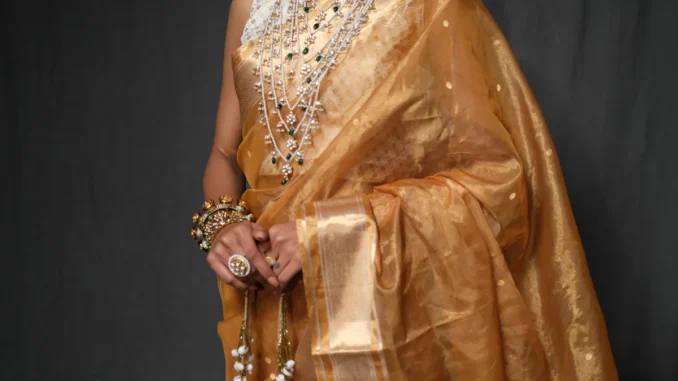
The desert is not just a backdrop; it’s a storyteller in its own right. It’s far more than an expanse of sand; it’s a living canvas that whispers tales of time, resilience, and breathtaking beauty. The endless expanse of sand, the rich, earthy tones of terracotta, ochre, and deep maroon, and the quiet serenity of the desert evening have all influenced fashion.
Think of the sun-bleached architecture of Rajasthani havelis, the soft, dusty pinks of Jaipur’s walls at dawn, or the deep, earthy ochre of the local community’s homes. These aren’t just colours; they are stories. The palette is one of survival and grace, from the hardy khejri tree to the vibrant burst of a woman’s leheriya dupatta against the muted landscape. This fashion is about honouring that spirit. It’s about an elegance that is quiet, profound, and deeply connected to the earth.
Wearing these colours is about embracing their inherent honesty and texture. It’s a dialogue between fabric and hue. These tones come alive on materials that breathe and tell their own story.
Tips
- Embrace the interplay of textures. The soul of this look is in the mix. Pair the rustic simplicity of linen or khadi with the gentle sheen of Chanderi or raw silk. A simple linen dress can be transformed by layering a sheer, hand-embroidered Chanderi overlay on top. It’s sophisticated and thoughtful.
- Create a conversation with colour. Let the earthy base be your canvas. A pop of fuchsia, emerald green, or a vibrant turquoise in a blouse, a dupatta, or even just in the embroidery, is a nod to the brilliant colours found in Rajasthani craft and culture. It’s balance, not noise.
- Let craftsmanship be your statement. Instead of overwhelming the look with heavy jewellery, let the garment speak for itself. A beautifully hand-block printed skirt, a kurta with very delicate gota patti work, or a jacket with intricate dori embroidery becomes the focal point. The elegance is in the art.
- Don’t create a cacophony. Each handcrafted piece has a story and a rhythm. Wearing too many bold patterns or loud motifs at once can drown out the beauty of the individual craft. Respect the narrative of each garment.
- Don’t sacrifice comfort for style. The very essence of desert-inspired dressing is ease and breathability. Choose fabrics that feel good against your skin and allow you to live, celebrate, and move freely. This is about dressing for life, not just for an occasion.
Diwali is a celebration of light, of homecoming. Your attire should reflect that warmth and joy without being cumbersome. This is where the intersection of comfort and quiet luxury truly shines.
Alternatively, a beautifully tailored silk tunic suit in a jewel tone like emerald or sapphire is perfect. Think of a rich, deep colour crafted from raw silk, which has a wonderful, subtle texture that photographs so well in the warm glow of festive lights. This rich, solid colour then becomes the perfect canvas for the true masterpiece: the hand-embroidered dupatta. Imagine a dupatta adorned with delicate dori work and shimmering zari, perhaps telling a story with motifs inspired by Rajasthan’s famed Pichwai paintings – lotuses blooming in fine threadwork or peacocks dancing. It’s regal without being overwhelming.
Ultimately, this style of dressing is an extension of a life lived with intention. It’s about finding beauty in simplicity and strength in heritage. Our collective goal should always be about bringing the dignity of craft and the craftsmen to the forefront.
When you choose a hand-block printed garment or a piece with intricate embroidery, you’re not just wearing a beautiful outfit. You are holding a piece of history, supporting an artisan’s livelihood, and preserving a craft that has been passed down through generations. Fashion, for me, must have a purpose. It should make you look good, but it must also feel good and do good. That is the true, enduring beauty of these desert-inspired stories we wear.
For women, think layered lehengas in muted gold organza with Kantha-inspired thread work. For men, a sand-coloured bandhagala in raw silk with minimal antique embroidery. They feel celebratory but still sophisticated the kind of pieces you’ll wear long after the festival.
At the end of the day, festive dressing should spark joy. Whether it’s through a bold pop of colour, a piece of jewellery you love, or a family heirloom dupatta it should feel you. I believe in celebrating individuality, and at Pink City, our mission is to create pieces that feel rooted in heritage but are light, modern, and accessible. Clothes should make you feel like yourself just a more luminous, festive version.
Read the full story that first appeared in Marwar India here:

Leave a Reply